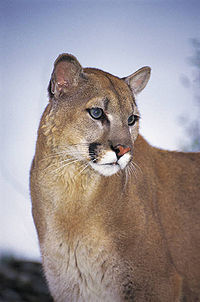Mountain Lion
 From Conservapedia
From Conservapedia | Mountain lion | |
|---|---|

| |
| Scientific classification | |
| Kingdom Information | |
| Kingdom | Animalia |
| Phylum Information | |
| Phylum | Chordata |
| Class Information | |
| Class | Mammalia |
| Order Information | |
| Order | Carnivora |
| Family Information | |
| Family | Felidae |
| Genus Information | |
| Genus | Puma |
| Species Information | |
| Species | P. concolor |
| Synonyms | Puma Painter Catamount Cougar |
| Subspecies | P. c. cabrerae P. c. costaricensis P. c. anthonyi P. c. coryi P. c. puma P. c. concolor |
| Population statistics | |
| Population | 30,000 |
The mountain lion or puma (Puma concolor) is a predatory feline native to the Americas, and the fourth-largest big cat (after the tiger, lion, and jaguar).
Contents
- 1 Name
- 2 Description
- 3 Behavior
- 3.1 Territory and range
- 3.2 Hunting
- 3.3 Breeding
- 4 Relation to man
Name[edit]
Various local dialects in North America gave the mountain lion additional names: deer tiger, deer stalker, mountain screamer, and many others. The word panther is in reference to all big cats that the early European colonists were familiar with; painter may have been an altered form of that word.
Catamount is synonymous with mountain lion, and means "cat of the mountain" [1]. Puma has its origins with the Incas of Peru. [2]
Description[edit]
Mountain lions are approximately 8 feet long from nose to tail, which is itself one-third of the total body length. They weigh between 75-200 pounds, with rare individuals weighing more. Females are slightly smaller.
The coat is a tawny light-brown with a white underside; occasional individuals will sport either lighter or darker coats. The tail is tipped in black, and the face has a dark brown patch on either side of the muzzle. The fur is short and coarse. [3]
Behavior[edit]
Territory and range[edit]
A typical mountain lion inhabits a range of territory that covers anywhere between 25 and 785 square miles, depending upon the availability of food and undisturbed habitat. All lions are solitary, and only get together during the breeding season.
Mountain lions have the greatest overall range of any species of mammal in the Western Hemisphere; although reduced in numbers in North America, mountain lions are found as far north as northern British Columbia in Canada to as far south as southern Chile and Argentina in South America, and they inhabit a variety of locations, from mountains to desert to forested woodlands and tropical rain forests.
Hunting[edit]
Mountain Lions hunt from ambush, either using cover to wait for prey to wander by, or using cover when they silently get near prey in which a sudden run is necessary. Like other big cats, mountain lions bite down on the neck, securing a strangulation hold on the victim's windpipe if it is a deer or larger, or breaking the neck if it is small game, such as a rabbit or marmot. Mountain Lions also feed on mice, ground squirrels, skunks, porcupines, and birds.
Mountain lions can consume up to 20 or 30 pounds of meat in a single meal, and if the prey is large enough, it will be cached in a secluded spot for further consumption, generally up to ten days.
Breeding[edit]
Mating and breeding can occur during any time of the year, but kittens are usually born in late spring/early summer. The courtship lasts only for a period of several days; after which the female finds a den as a secure place to give birth.
Mountain Lion kittens are born with a spotted coat and bright blue eyes. The spots disappear after 6–9 months, and the eyes turn yellow within 16 months. Weighing in at about one pound at birth, the kittens grow rapidly. After eight weeks of nursing, the kittens will weigh about 30 pounds. Lion kittens begin to eat meat at the age of six weeks. After 18 months, the immature lions usually leave their mother to begin life on their own.
Juvenile lions lead a tough life during the first two years. Dominant males may kill juveniles within their territories, so often juveniles must eke out a living in marginal habitat. This can ultimately lead to starvation or encounters with humans. Even in California where Mountain Lions are protected from hunting, 75% of the kittens die prior to the end of their second year.
Relation to man[edit]
Mountain lions were persecuted throughout much of the history of the United States, as they were seen to be a threat to livestock; once common east of the Mississippi River, they are now seen sporadically; the subspecies P. c. coryi is restricted to remote areas of the Florida Everglades and is listed as endangered. [4]
They are more common in the American west where much undisturbed habitat remains, but as development moves inward, human/lion encounters are becoming more frequent; attacks by lions have increased since 1991, resulting in a number of well-publicized deaths. [5]
| ||||||||||||||||||||||||||||||||||||||||||||
Categories: [Felines]
↧ Download as ZWI file | Last modified: 02/25/2023 01:56:46 | 10 views
☰ Source: https://www.conservapedia.com/Mountain_lion | License: CC BY-SA 3.0
 ZWI signed:
ZWI signed: KSF
KSF